
Three days, two nights backpacking in the Olympic Mountains
July 12-14, 2019
I signed up for the Lena Lake trip on MeetUp. I didn’t know anybody in the group, so it seemed like a great opportunity to both meet new people and explore a new area.
I met up with Rachel, Kim, Angelica, and Veronica in Olympia, and we set off for Lena Lake, arriving at the trailhead at 3:30 p.m. The weather was beautiful–sunny, but not too hot. The parking lot was only about half full, which was probably not unusual for a Friday afternoon. We were happy about that because it meant we were likely to get one of the 28 coveted camping spots.
The trail was pretty easy at first, but then we started climbing pretty steeply, zig zagging on switchback over switchback, seventeen times (topographic map). It was pretty brutal. A mile of switchbacks, climbing 700 feet. I stopped halfway up and removed my pant legs and long-sleeve shirt to cool off a bit.
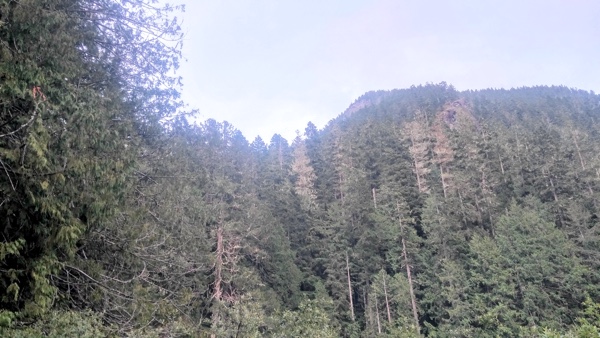 There were lots of day hikers on the trail. Families with kids, people walking their dogs, and couples and friends of all ages and genders. Lots of people out having fun and communing with nature. It was great to see.
There were lots of day hikers on the trail. Families with kids, people walking their dogs, and couples and friends of all ages and genders. Lots of people out having fun and communing with nature. It was great to see.
About an hour and 15 minutes into the climb, we reached reached a gorge filled with giant boulders. It was pretty amazing. Unfortunately, I didn’t think to get a photo. D’oh! A few yards later, and we arrived at the halfway point–the bridge over Lena Creek–and took a short break. It was a welcomed rest! I took advantage of the break to get some water, a couple handfuls of trail mix, and remove my t-shirt. I felt pretty good. I wasn’t having any difficulty carrying my pack, and although the hike was tough, it wasn’t too strenuous.
After about ten minutes, we shouldered our packs and started climbing again. We went another mile, and then I really started feeling it in my legs. It was hard. I had climbed about 1200 feet by then, over the three miles, and my legs were beginning to shake. My backpack straps were rubbing the areas of my shoulders not protected by my tank top straps, causing some irritation. We still had about a mile to go, and I couldn’t wait to get to camp. 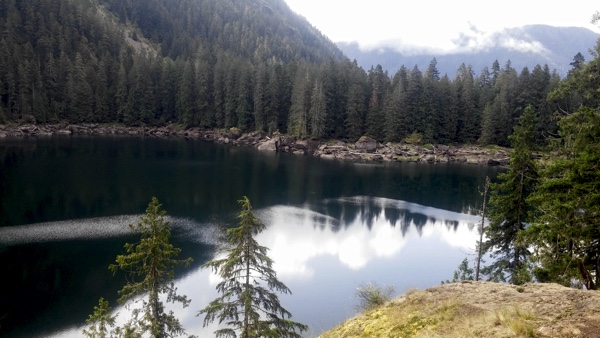 By then, we were seeing tantalizing glimpses of the lake through the trees, and then the trail started a long descent to the lake. It seemed to be rockier and have more exposed roots at this point, requiring me to be more vigilant with my footing. But, the lake was within sight. The end was near!
By then, we were seeing tantalizing glimpses of the lake through the trees, and then the trail started a long descent to the lake. It seemed to be rockier and have more exposed roots at this point, requiring me to be more vigilant with my footing. But, the lake was within sight. The end was near!
Finally, we came to Lena Creek on the northern edge of the lake. It was a beautiful, clear, bubbling, fast-moving stream. It had a bridge at one time, but it is now long gone. The only crossing now is some small logs. Two stuck out parallel to each other, perpendicular to the bank, covering about 2/3 of the creek. Another log leaned up against a fourth, jutting out from the far bank, forming the rest of the crossing. We would have to walk across the two, climb down onto the third, and then up it and over the fourth to reach the bank on the other side. It was pretty intimidating. Especially since my legs were already weary and shaking from the long, arduous climb and then descent.
Kim went first, bouncing up and down on the logs to check for stability. None moved. It looked stable and kinda sorta somewhat safe, as long as one didn’t lose their balance or slip. She dropped off her pack on the opposite bank and crossed back part way to help the rest of us. Two more women crossed, and then it was my turn. I was pretty anxious, so Kim came across to help me. I think someone may have helped me from behind, as well, but I don’t really remember. I was completely focused on Kim in front of me. She lent me a hand and let me lean on her shoulders as I inched across the logs and then carefully climbed down onto the third. I made it across safely! Woohoo!
A quarter mile later and at about 7:00 p.m., we found a campsite large enough for all five of us overlooking the northeastern end of the lake. 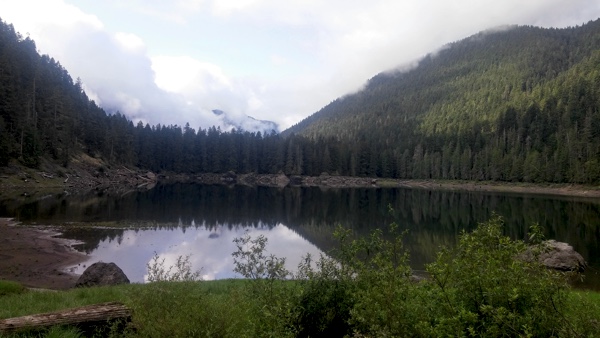 We saw several occupied campsites on the trek around the lakeshore, but there were lots of smaller empty ones, as well. They would fill up as more people hiked in on Saturday. Most had some slope to them, as did ours, but we made do, with everyone setting up tents with our feet pointing downhill.
We saw several occupied campsites on the trek around the lakeshore, but there were lots of smaller empty ones, as well. They would fill up as more people hiked in on Saturday. Most had some slope to them, as did ours, but we made do, with everyone setting up tents with our feet pointing downhill.
We were all pretty tired, so after setting up camp, we ate dinner, sat around and talked for a bit, and then headed off to bed not long after sunset. The waxing moon cast plenty of light over the valley, reminiscent of late summer evenings in my Alaskan home town.
I didn’t really sleep very well. I usually don’t, even at home. My sleeping pad kept sliding downhill, taking me with it, causing me to wake up every half hour or so scrunched up at the bottom of my tent.
I gave up on sleep as the sun began to rise and walked the quarter mile to the stream for water. I took my LifeStraw with me, thinking I’d give it another try. It had been an abysmal failure on my hike with the Mountaineers the previous month. And again, it did not fail to disappoint. I simply could not get enough water through it, even after letting the filter soak overnight. I had even tested it at home, using just regular tap water, always with the same sad results. In the end, I used the bottle to gather water to take back to camp and boil. What a disappointment!
After breakfast, three of our group set off for a day hike to Upper Lena Lake. Rachel stayed behind to read and relax, and I was glad for her company. I’d heard the hike to Upper Lena Lake was really hard, and I was concerned it might be beyond my abilities. I pulled out my topographic map, and yeah, it looked really tough. I was REALLY glad I hadn’t gone. I have nothing to prove to anyone, nor do I have any desire to put myself or anyone else in a potentially dangerous situation. After the previous day’s hike, spending some time relaxing and exploring the area around Lena Lake sounded inviting. While my map was out, I practiced orienteering, making note of the mountain peaks, ridges, valleys, and “folds” in the hillsides that indicated streams.
During an early afternoon water-gathering trip, I took off my shoes and socks to wash my feet in the stream. The cold, clean water felt great! Unfortunately, as soon as I got in the water, I felt raindrops. That was unexpected! I had left the rain fly open on my tent to let it air out, and my boots and other gear were sitting out, as well. And, I knew my campmates had left out backpacks, shoes, and other gear. I put on my socks and shoes as fast as I could and quickly hiked the quarter mile back to camp.
It was really coming down by the time I got there. I closed up my tent, covered up my boots, and stashed the rest of the gear laying around camp. Rachel was in her tent sleeping. I didn’t want to get my tent and gear any wetter by climbing in during the rainstorm, so I sat out under a tree, made soup, and boiled more water while waiting for the storm to pass. 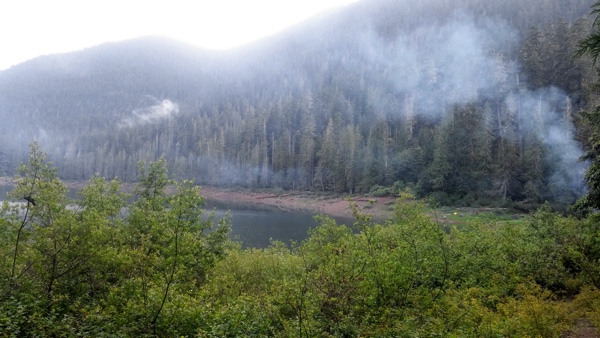 It was mostly dry under the tree, and I had a great view of the rain falling on the lake and campfire smoke rising lazily through the trees in the distance as the hot soup spread its warmth through my body. It was super peaceful.
It was mostly dry under the tree, and I had a great view of the rain falling on the lake and campfire smoke rising lazily through the trees in the distance as the hot soup spread its warmth through my body. It was super peaceful.
The rain didn’t last long. I used a t-shirt to dry off my tent fly after the rain ended, climbed in, and napped the rest of the afternoon until everyone else got back. It was a great day to just be lazy, something I don’t take time to do very often. And Kim, Veronica, and Angelica had had a great hike! They even saw a bear. And yes, they said it was as strenuous as the map showed it to be. All three were quite sore and hungry.
It was another early night. I took a couple Excedrin PM and this time was able to get some good sleep, despite waking up periodically to reposition myself.
We took our time packing up in the morning and hit the trail shortly after 9:00 a.m. Fortunately, this time, we had the scary river crossing at the beginning of our hike, instead of the end. However, the logs were slippery from the previous day’s rain, making the crossing was even harder and scarier. Kim ferried my pack across for me, and then helped me cross the logs. My legs were shaking pretty badly by the time I got across, but I made it! Woohoo! Again, I was very thankful for her help.
The hike out was at a faster pace than the hike in. I managed to do OK for the first three miles again, but by the time I hit those switchbacks, I was pretty much done in. Hiking downhill is really hard on me, especially with a backpack.
Moreover, I had brought only 350ml of water, thinking it would be plenty for the hike out, especially with a significantly lighter pack, but it wasn’t. Even though it wasn’t hot, I needed more. I could tell I was getting a little dehydrated. That damn LifeStraw! If that thing had worked, I would have had twice as much water! On the other hand, I had also wanted to reduce my pack’s weight by carrying only the water I thought I would need, so the LifeStraw’s ineffectiveness wasn’t the only cause. My own backpacking inexperience was, as well. I will know better than to repeat this mistake.
My butt was really dragging that last mile, and my pace had slowed considerably. I was really working my trekking poles to help maintain my balance and reduce the impact on my knees. Suddenly, I heard someones shout “We farted!” in unison. Two campmates had gone on ahead and were letting us know they had just reached the trailhead. I burst out laughing and shouted “I farted, too!” in acknowledgment. Our first night at the lake, we had heard a couple of young women shout that from across the valley.
A few minutes later, I saw windshields glinting in the sun, and then the trailhead was in sight. Woohoo! I survived! I was exhausted. The hike out had taken a little more than three hours, including stopping at the halfway point for a chat with some mountain goat relocation program volunteers.
I threw my pack in the back of the truck with the others, and after a quick bathroom break, we headed toward Hoodsport for the burgers we’d talked about all weekend. I didn’t make it very far before Kim offered to drive. I readily accepted and, except for a quick stop at the Burger Stand in Hoodsport, slept all the way to Olympia.
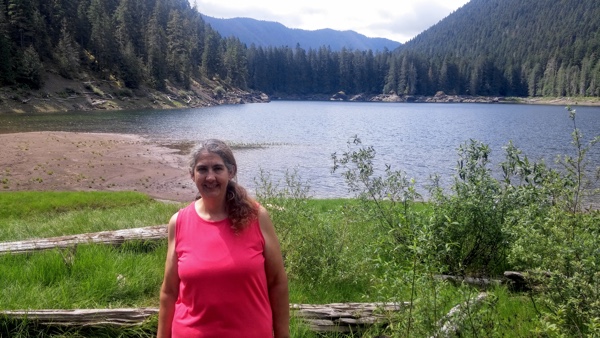 It was a great weekend. I really enjoyed the company of Kim, Angelica, Veronica, and Rachel. I was older than them by at least 25 years, but it didn’t matter. We had fun. And I really appreciated Kim’s help. She was the hike organizer, and she kept the group together. I never once felt I was being rushed or pressured to hike beyond my means. In fact, the pace of our hike gave her the opportunity to use her camera and take some good photos. She made sure we all crossed the river safely, and she was very knowledgeable about the area.
It was a great weekend. I really enjoyed the company of Kim, Angelica, Veronica, and Rachel. I was older than them by at least 25 years, but it didn’t matter. We had fun. And I really appreciated Kim’s help. She was the hike organizer, and she kept the group together. I never once felt I was being rushed or pressured to hike beyond my means. In fact, the pace of our hike gave her the opportunity to use her camera and take some good photos. She made sure we all crossed the river safely, and she was very knowledgeable about the area.
Lessons learned
My takeaways from this trip, in no particular order:
- I need to improve my water filtration system. I had purchased the LifeStraw to use when kayaking as it seemed like a reasonable way to get water while out on the lake and with limited space. However, it is completely ineffective, and my attempts to contact the manufacturer for assistance have proven fruitless.
- I need to rethink my cookware. I took only a stainless steel cup and a silicon cup on my trip with the Mountaineers, and although it worked great for cooking oatmeal and other single-serving meals, it just took too long to boil water in the steel cup. For this trip, I added a small pan, which is wider and shallower. But, it still took too long to boil water because the pan had no lid, and having all three seemed redundant. I would be better served not bringing the steel cup and instead bringing the other half of my pan set, so one could be used as a lid, while the other used for cooking and boiling water.
- A fleece bag liner might be overkill during the summer. I was plenty warm. I could save a few ounces and space and still protect my sleeping bag by getting a lighter liner for the summer months.
- My heavy wool Napapijri sweater was overkill. I had originally packed my lighter weight REI quilted shell, but swapped it for the sweater at the last minute because I was concerned about the cooler mountain air. However, I had also packed a lighter REI wool sweater, which I never used. It and the quilted shell probably would have been sufficient and would have saved both weight and space.
- I was wise to contact the hike organizer beforehand and ask about hiking pace. That way, she knew I was not a fast hiker, and I knew the group would stay together and not be in such a hurry to get to the campsite. She also knew she would then be able to take plenty of photos. We all knew the hike expectations ahead of time, so it was win/win.
- I underestimated the amount of water I needed for the hike out and should have taken twice as much. See takeaway #1.
- I brought only one pair of convertible pants with me–the pair I wore. Next time, I need to bring at least a pair of light-weight shorts. On both this trip and my last (a car camping trip, not a backpacking trip), I had opportunities to go swimming and chose not to rather than get my one and only pair of pants (and underwear) wet. Also, if my pants had gotten wet, it would have given me something to wear while they were drying.
- My brand-new canister of gas exploded under pressure when I attached the stove, spraying fuel on my t-shirt, hands, and face. I had no idea it would do that, and, fortunately, nothing bad happened except I had to thoroughly wash my hands and face and toss a new t-shirt. Next time, I need to remember to attach the stove well away from the campfire and keep it pointed away from my face.
- Using my silicon cup as a lid when boiling water in the stainless steel cup…not such a great idea. It worked fabulously before, but melted a small hole in it this time. D’oh! It was a good experiment, however.
- The auto igniter on my stove didn’t always work and I had to resort to using a lighter twice. Hmmm. I’m glad I brought a lighter!
- I should see about getting some kind of inflatable pool floatie to put under my feet at night so I can sleep on my back and give my hips some relief from the hard ground.
What worked well:
- My cheap little Amazon Flytop tent again worked fabulously.
 The rainfly protected it from both rain and heavy dew, keeping everything underneath it dry, with no condensation whatsoever.
The rainfly protected it from both rain and heavy dew, keeping everything underneath it dry, with no condensation whatsoever. - The Under Armor hiking boots my ex gave me for Christmas again worked fabulously. My feet felt great! No blisters and no tired arches, and they kept my feet dry when wading through mud and shallow streams.
- Using both ThermARest pads worked great! I packed the rigid foam one for the first time and used it under the inflatable pad. It did not add to my pack weight (about 33 pounds) or significantly increase bulk. It was also a great place to store my topographic map.
- That stupid inflatable travel pillow was actually pretty comfortable. The trick to using it is to inflate it only about half to 2/3, rather than completely.
- Turning off bluetooth and wireless and setting my phone to airplane mode resulted in my phone battery lasting the entire trip, with very little battery drain, despite my using the camera function.
- Lena Lake is both a day hike and a backpacking destination that I would feel comfortable doing alone. There were always plenty of people around, and yet there was also enough privacy that we felt comfortable peeing in the woods, rather than always trekking to the toilet up the mountainside. The lake is in a valley, and shouting is easily heard by everyone in the vicinity. Moreover, there are no bears. And, there are no bears. Just thieving chipmunks, field mice, and birds. If I had to ford the stream alone, I would probably come prepared to wade across at a point a little downstream, rather than balance precariously on slippery logs.
Conclusion
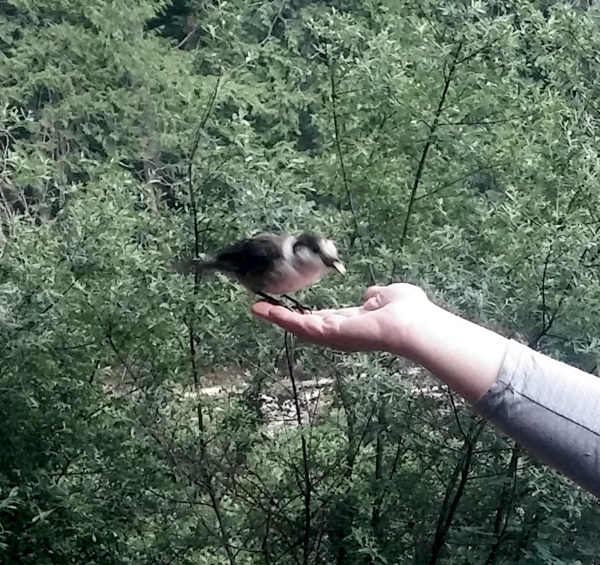 I’m really glad I did this trip. Yes, it was hard–really hard for me. But, it was also empowering. The hike to Lower Lena Lake at four miles and 1400 feet elevation gain (according to Garmin) was by far harder than the North Fork of the Sauk River hike, which is the same distance and about half the elevation gain. And I did it. It was also my very first two-night backpacking trip. I’d love to do it again!
I’m really glad I did this trip. Yes, it was hard–really hard for me. But, it was also empowering. The hike to Lower Lena Lake at four miles and 1400 feet elevation gain (according to Garmin) was by far harder than the North Fork of the Sauk River hike, which is the same distance and about half the elevation gain. And I did it. It was also my very first two-night backpacking trip. I’d love to do it again!
Stats
Trail rating*: 106, or moderately strenuous, based on the four mile hike to the Lena Lake Campground and 1400′ elevation gain.
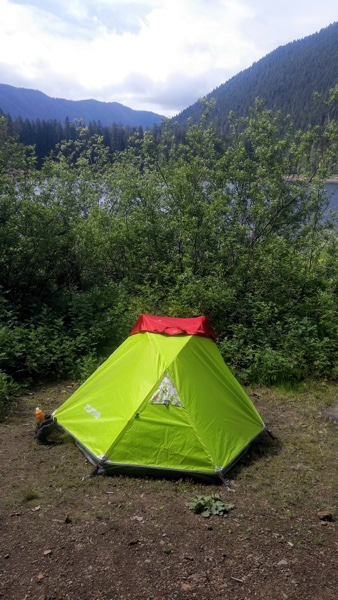 The rainfly protected it from both rain and heavy dew, keeping everything underneath it dry, with no condensation whatsoever.
The rainfly protected it from both rain and heavy dew, keeping everything underneath it dry, with no condensation whatsoever.